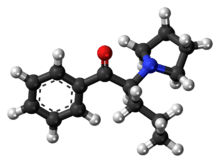alpha-Pyrrolidinopentiophenone
α-Pyrrolidinopentiophenone (also known as α-pyrrolidinovalerophenone, α-PVP, O-2387, β-keto-prolintane, prolintanone, or desmethylpyrovalerone) is a synthetic stimulant of the cathinone class developed in the 1960s[1] that has been sold as a designer drug.[2] Colloquially, it is sometimes called flakka.[note 1] α-PVP is chemically related to pyrovalerone and is the ketone analog of prolintane.[5]
 | |
 | |
| Clinical data | |
|---|---|
| Routes of administration | oral, intranasal, vaporization, intravenous, rectal, sublingual |
| Legal status | |
| Legal status |
|
| Identifiers | |
| |
| CAS Number | |
| PubChem CID | |
| ChemSpider | |
| UNII | |
| ChEMBL | |
| CompTox Dashboard (EPA) | |
| Chemical and physical data | |
| Formula | C15H21NO |
| Molar mass | 231.339 g·mol−1 |
| 3D model (JSmol) | |
| |
| |
| | |
Adverse effects
α-PVP, like other psychostimulants, can cause hyperstimulation, paranoia, and hallucinations.[6] α-PVP has been reported to be the cause, or a significant contributory cause of death in suicides and overdoses caused by combinations of drugs.[7][8][9][10] α-PVP has also been linked to at least one death with pulmonary edema and moderately advanced atherosclerotic coronary disease when it was combined with pentedrone.[11]
Pharmacology
α-PVP acts as a norepinephrine-dopamine reuptake inhibitor with IC50 values of 14.2 and 12.8 nM, respectively, similar to its methylenedioxy derivative MDPV.[12][13][14][15] Similar to other cathinones, α-PVP has been shown to have reinforcing effects in rats.[16][17]
Chemistry
α-PVP gives no reaction with the Marquis reagent. It gives a grey/black reaction with the Mecke reagent.[18]
Detection in body fluids
α-PVP may be quantified in blood, plasma or urine by liquid chromatography-mass spectrometry to confirm a diagnosis of poisoning in hospitalized patients or to provide evidence in a medicolegal death investigation. Blood or plasma α-PVP concentrations are expected to be in a range of 10–50 μg/L in persons using the drug recreationally, >100 μg/L in intoxicated patients and >300 μg/L in victims of acute overdosage.[19][20]
Society and culture
Legal status
α-PVP is a Schedule I drug in New Mexico, Delaware, Florida, Oklahoma, and Virginia. On January 28, 2014, the U.S. DEA listed it, along with nine other synthetic cathinones, on the Schedule 1 with a temporary ban, effective February 27, 2014.[21] The temporary ban was then extended.[22]
As of October 2015, α-PVP is a controlled substance in China.[23]
Italy classified cathinone and all structurally derived analogues (including pyrovalerone analogues) as Narcotics on January 2012.[24][12]
In Australia Alpha-PVP is a Schedule 9 prohibited substance under the Poisons Standard (July 2016).[25] A Schedule 9 substance is a substance which may be abused or misused, the manufacture, possession, sale or use of which should be prohibited by law except when required for medical or scientific research, or for analytical, teaching or training purposes with approval of Commonwealth and/or State or Territory Health Authorities.[25] The drug was explicitly made illegal in New South Wales after it was illegally marketed with the imprimatur of erroneous legal advice that it was not encompassed by analog provisions of the relevant act. It is encompassed by those provisions, and therefore has been illegal for many years in New South Wales. The legislative action followed the death of two individuals from using it; one jumping off a balcony, another having a heart attack after a state of delirium.[26][27]
α-PVP is banned in Estonia, Finland, France, Germany, Hungary, Ireland, Latvia, Lithuania, Poland, Romania, Slovenia, Sweden, United Kingdom, Turkey, Norway,[12] as well as the Czech Republic.[28]
Economics
α-PVP is sometimes the active ingredient in recreational drugs sold as "bath salts".[26] It may also be distinguished from "bath salts" and sold under a different name: "flakka", a name used in Florida, or "gravel" in other parts of the U.S. It is reportedly available as cheaply as US$5 per dose.[29] A laboratory for one county in Florida reported a steady rise in α-PVP detections in seized drugs from none in January–February 2014 to 84 in September 2014.[30]
See also
- α-Pyrrolidinohexiophenone (α-PHP)
- α-Pyrrolidinopentiothiophenone (α-PVT)
- α-PCYP
- 4'-Methoxy-α-Pyrrolidinopentiophenone
- Naphyrone (O-2482)
- Pentedrone
- Pentylone
- Prolintane
- Pyrovalerone (O-2371)
References
- GB 927475, "α-Pyrrolidinovalerophenones", published May 29, 1963
- Logan BK (September 13, 2013). "SOFT Designer Drug Committee Monographs: Alpha-PVP" (PDF). Society of Forensic Toxicologists. Archived from the original (PDF) on April 6, 2015.
- Coubrough J (November 2, 2017). "'Zombie drug' flakka may have hit Winnipeg streets: police". CBC News.
- England C, Garcia F (August 17, 2016). "Flakka: What is the 'zombie drug' blamed for face-eating attacks?". The Independent.
- Sauer C, Peters FT, Haas C, Meyer MR, Fritschi G, Maurer HH (June 2009). "New designer drug alpha-pyrrolidinovalerophenone (PVP): studies on its metabolism and toxicological detection in rat urine using gas chromatographic/mass spectrometric techniques". Journal of Mass Spectrometry. 44 (6): 952–64. Bibcode:2009JMSp...44..952S. doi:10.1002/jms.1571. PMID 19241365.
- "Drugs of Abuse Emerging Trends". National Institute on Drug Abuse. 6 April 2015.
- Marinetti LJ, Antonides HM (April 2013). "Analysis of synthetic cathinones commonly found in bath salts in human performance and postmortem toxicology: method development, drug distribution and interpretation of results". Journal of Analytical Toxicology. 37 (3): 135–46. doi:10.1093/jat/bks136. PMID 23361867.
- Richards-Waugh LL, Bailey KM, Clay DJ, Gebhardt MA, Newsome-Sparks CL, Majmoud HE, Venuti SE, Kraner JC (2013). "t" (PDF). AAFS Proceedings. Abstract K16. Archived from the original (PDF) on 2016-11-08. Retrieved 2015-04-03.
- "Cheap, synthetic 'flakka' dethroning cocaine on Florida drug scene".
27 people have died from flakka-related overdoses in the last eight months in Broward County
- Klavž J, Gorenjak M, Marinšek M (August 2016). "Suicide attempt with a mix of synthetic cannabinoids and synthetic cathinones: Case report of non-fatal intoxication with AB-CHMINACA, AB-FUBINACA, alpha-PHP, alpha-PVP and 4-CMC". Forensic Science International. 265: 121–4. doi:10.1016/j.forsciint.2016.01.018. PMID 26890319.
- Sykutera M, Cychowska M, Bloch-Boguslawska E (May 2015). "A Fatal Case of Pentedrone and α-Pyrrolidinovalerophenone Poisoning". Journal of Analytical Toxicology. 39 (4): 324–9. doi:10.1093/jat/bkv011. PMID 25737339.
- "EMCDDA–Europol Joint Report on a new psychoactive substance: 1-phenyl-2-(1-pyrrolidinyl)-1-pentanone (α-PVP)". European Monitoring Centre for Drugs and Drug Addiction (EMCDDA). September 2015.
- Marusich JA, Antonazzo KR, Wiley JL, Blough BE, Partilla JS, Baumann MH (December 2014). "Pharmacology of novel synthetic stimulants structurally related to the "bath salts" constituent 3,4-methylenedioxypyrovalerone (MDPV)". Neuropharmacology. 87: 206–13. doi:10.1016/j.neuropharm.2014.02.016. PMC 4152390. PMID 24594476.
- Rickli A, Hoener MC, Liechti ME (March 2015). "Monoamine transporter and receptor interaction profiles of novel psychoactive substances: para-halogenated amphetamines and pyrovalerone cathinones" (PDF). European Neuropsychopharmacology. 25 (3): 365–76. doi:10.1016/j.euroneuro.2014.12.012. PMID 25624004.
- Meltzer PC, Butler D, Deschamps JR, Madras BK (February 2006). "1-(4-Methylphenyl)-2-pyrrolidin-1-yl-pentan-1-one (Pyrovalerone) analogues: a promising class of monoamine uptake inhibitors". Journal of Medicinal Chemistry. 49 (4): 1420–32. doi:10.1021/jm050797a. PMC 2602954. PMID 16480278.
- Gannon BM, Galindo KI, Mesmin MP, Sulima A, Rice KC, Collins GT (May 2018). "Relative reinforcing effects of second-generation synthetic cathinones: Acquisition of self-administration and fixed ratio dose-response curves in rats". Neuropharmacology. 134 (Pt A): 28–35. doi:10.1016/j.neuropharm.2017.08.018. PMC 5809320. PMID 28811192.
- Gannon BM, Rice KC, Collins GT (October 2017). "Reinforcing effects of abused 'bath salts' constituents 3,4-methylenedioxypyrovalerone and α-pyrrolidinopentiophenone and their enantiomers". Behavioural Pharmacology. 28 (7): 578–581. doi:10.1097/FBP.0000000000000315. PMC 5599337. PMID 28570297.
- "Reactions table". Reagent Base. Archived from the original on 2015-12-08. Retrieved 3 December 2015.
- Eiden C, Mathieu O, Cathala P, Debruyne D, Baccino E, Petit P, Peyriere H (November 2013). "Toxicity and death following recreational use of 2-pyrrolidino valerophenone". Clinical Toxicology. 51 (9): 899–903. doi:10.3109/15563650.2013.847187. PMID 24111554.
- Baselt RC (2014). Disposition of toxic drugs and chemicals in man. Seal Beach, Ca.: Biomedical Publications. p. 1751. ISBN 978-0-9626523-9-4.
- "2014 Rules, DEA/DOJ Diversion Control". Archive.CS1 maint: others (link)
- "Lists of:Scheduling Actions, Controlled Substances, Regulated Chemicals" (PDF). usdoj.gov. U . S . D e p a r t m e n t o f J u s t i c e. August 2016. Retrieved September 29, 2016.
- "关于印发《非药用类麻醉药品和精神药品列管办法》的通知" (in Chinese). China Food and Drug Administration. 27 September 2015. Archived from the original on 1 October 2015. Retrieved 1 October 2015.
- "Decreto 29 dicembre 2011 (12A00013) (G.U. Serie Generale n. 3 del 4 gennaio 2012)" (PDF). Archived from the original (PDF) on 2016-07-01. Retrieved 2016-05-28.
- Poisons Standard July 2016 Comlaw.gov.au
- Olding R. "'Bath salts' death: lethal drug was a top seller". The Sydney Morning Herald.
- "Flakka, synthetic drug behind increasingly bizarre crimes". AP. 30 Apr 2015.
- "Látky, o které byl doplněn seznam č. 4 psychotropních látek (příloha č. 4 k nařízení vlády č. 463/2013 Sb.)" (PDF) (in Czech). Ministerstvo zdravotnictví.
- Steinberg J (November 8, 2015). "Flakka: The New Illegal Drug You Need to Know About". Inc. Retrieved November 11, 2015.
- Alvarez T (April 2, 2015). "Flakka: Rampant designer drug dubbed '$5 insanity'". Sun-Sentinel. Fort Lauderdale, Fla.